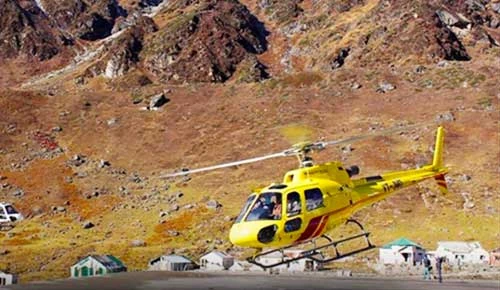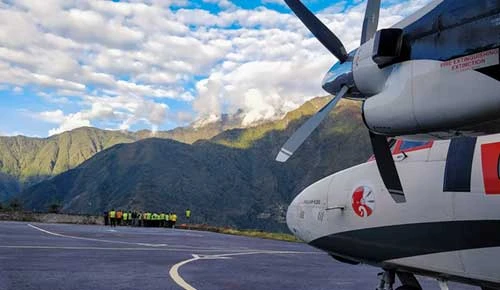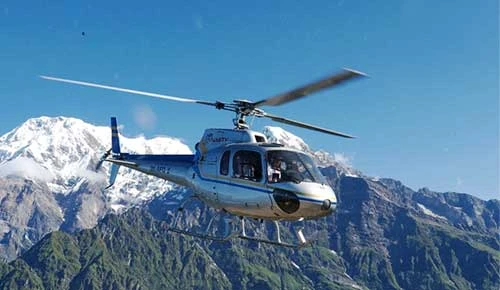One Way Trek to Everest Base Camp
Yes, it is possible to do a one way trek to Everest base camp and then return back in a helicopter flight. This option is getting more popular day by day due to its time flexibility.
We have a special package for this kind of trip, which is named the Everest base camp heli trek or helicopter return trek. Let's have a summary of the Heli return trip.
This trek is one of the thrilling and awe-inspiring journeys that help you set foot on the base of the world's tallest mountain.
This adventure is customized for those who crave the beauty of Everest but do not want to endure the strenuous trek back from base camp. The trek takes 11 days to complete and offers the beauty of the Himalayas.

The trekking journey begins with a picturesque flight from Kathmandu to Lukla, a charming hamlet in the Everest region. From there, you'll trek up to Everest base camp, passing through famous sites and relishing the natural splendor and mountainous vistas that surround you.
Your trek will culminate with an unforgettable sunrise view from Kala Patthar before you return to Gorak Shep. The return flight to Kathmandu from Gorak Shep is a thrilling helicopter ride that offers spectacular views of Mount Everest and the nearby peaks.
The helicopter ride will be a highlight of your trip, adding an extra dose of excitement to an already unforgettable experience. This adventure is perfect for those seeking to witness the grandeur of the Himalayas in a short period of time.
So, get ready for an exhilarating adventure that will take your breath away and create lifelong memories.
Table of Contents
Advantages
Here is a list of the advantages of booking a one-way trek to base camp:
- A helicopter return can shorten the two-week trek to Everest Base Camp.
- This trek allows you to see the Himalayas in a short period of time.
- Returning by helicopter gives a unique perspective on this trek's Himalayan sights.
- Mount Everest and other peaks are breathtakingly visible.
- With a helicopter return, you may save the physical strain of trekking.
- Trekking and helicopter rides are a unique experience that will last a lifetime.
- Due to extreme weather and terrain, Himalayan trekking is dangerous. Emergency helicopter returns improve safety.
- In an emergency, a helicopter return can make trekking in the Himalayas safer.
Best time
The best time to go on a helicopter return trek is during the spring (March to May) and autumn (September to November) seasons.
During these times, the weather is usually clear with stable atmospheric conditions, making it ideal for helicopter flights and trekking. The temperatures are also moderate, and the skies are less likely to be obscured by clouds or rainfall.
However, it's important to note that weather conditions can be unpredictable in the Everest region, so it's always best to consult with a local tour operator or guide for the latest information and to plan your trip accordingly.
Tips for Planning Your this trip
- Choose the Right Time: For good weather and mountain views, trek from March to May or September to November.
- Book a Reliable Trekking Company: Choose a reputable and experienced trekking company that offers helicopter services for the return from Everest base camp.
- Acclimatization is Key: High-altitude climbs require adequate rest days to acclimatize.
- Pack Smart: Bring layers for warm and cold weather, including a thick jacket, gloves, and a cap. Bring a good backpack and hiking boots.
- Avoid altitude sickness by staying hydrated.
- Trekking in the Himalayas is dangerous, so buy travel insurance that covers medical emergencies, helicopter rescue, and trip cancellation.
- Altitude sickness or other health conditions may need a helicopter evacuation. Plan for emergencies.
- To conserve Everest's delicate ecosystem and culture, follow environmental standards when trekking.
- Finally, keep positive and enjoy the journey. Enjoy the memorable climb to Everest Base Camp.
Cost: Is This Trip Worth It?
The cost of one-way heli trek is $1950. The cost may seem steep but it is definitely worth it for the incredible experience of the trek and tour that it offers.
This trek will take you through stunning natural landscapes, from verdant forests to snowy peaks, and give you an insight into the fascinating lifestyle of the indigenous Sherpa people.
Also, taking a helicopter back is an exciting option that not only saves time but also provides a bird's-eye perspective of the beautiful Himalayan terrain, adding to the adventure and excitement of the trek.
Therefore, a one-way trek to base camp and helicopter return is an opportunity not to be missed if you are looking for an unforgettable experience and have the time and money to do it.
Safety Considerations
Here are some of the safety considerations for one-way trek:
- The hike to base camp takes place at high altitude, which can be hard on your body. To go on the journey, you need to be in good physical shape.
- High altitudes can cause altitude sickness, which can be dangerous. To avoid altitude sickness, it's important to get enough rest and let your body adjust.
- In the Himalayas, the weather can be hard to predict and can change quickly. It's important to be ready for cold temperatures, high winds, and snow, among other extreme weather conditions.
- It's important to have a trustworthy way to get help in an emergency. When trekking in the Everest area, many people choose to be rescued by helicopter. However, it's important to make sure that the helicopter service company has a good safety record.
- For travels, it's important to have the right equipment and gear, like sturdy hiking boots, warm clothes, a sleeping bag, and a backpack. It's also important to make sure that the gear is in good shape and has been tried before the trek.
- It's important to use good hygiene and sanitation techniques on the trek to avoid getting sick. Carrying enough clean drinking water, hand sanitizers, and disinfectants is important.
- A guide with a lot of knowledge is important for safety when you go trekking. A guide can tell you important things about the landscape, the weather, and altitude sickness. They can also help find possible dangers and give first aid if something goes wrong.
- It's important to make sure you have enough trip insurance that covers emergency medical costs, such as being taken away by helicopter.
Alternative Helicopter Service in the Everest Region
These are the lists of several alternative helicopter services available in the Everest region. Some of the popular ones include:
Role of Helicopter Tours in the Future of Mountaineering
Helicopter tours have been a big part of the tourism business, and you can't forget how they've changed mountaineering. In recent years, helicopter tours have become a popular way to get to places like high peaks that are hard to get to.
This trend is likely to keep going, and helicopter tours will likely be a big part of climbing in the future. Tourists can see the breathtaking beauty of mountain ranges without having to walk.
They also give you a unique look at the mountain surroundings that you can't get from the ground. But it's important to remember that helicopter trips shouldn't replace traditional mountaineering because they can hurt the environment and lead to too many people on the mountain.
So, it's important to find a balance between using helicopter tours and keeping the natural surroundings safe.
Environmental Impact of Helicopter Tour
While helicopter tour to Everest base camp can have negative environmental impacts, such as noise pollution and disturbance to wildlife, they can also have some positive impacts if managed properly.
Here are some ways in which helicopter tours can have a positive environmental impact:
- Reduced carbon emissions: helicopter rides reduce the number of trekkers, reducing their transportation, housing, and food needs.
- Increased awareness: Tourists on helicopter tours are more likely to appreciate the natural beauty of the Everest region and the need to maintain it.
- Economic benefits for conservation: Helicopter tours can generate revenue that can be used for conservation efforts in the Everest region. Tour operators can donate a part of their income to reforestation, wildlife protection, or trash management projects.
- Emergency response: Helicopter tours can help with Everest medical and accident response. Search and rescue activities can save lives and lessen environmental impact.







